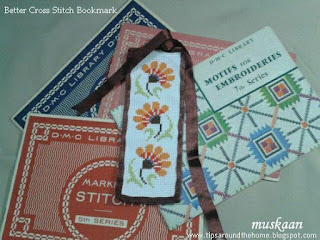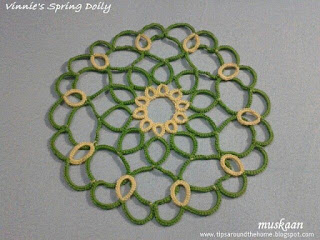Yay , I
finally reached my study for the monthly pinterest challenge ! Er, not to dust
the books & shelves, but within the pages of my books. And look, Suzanne,
no tatting :-)))
I love to
hand embroider, especially freehand styles – lines or fillings, choosing from
the multitude of stitches, & embroidering with a single strand of thread.
Not
possible now, so I fell back on counted cross stitch. I’ve done my share of
cross stitch projects, though it is not my favorite style. This time it got so
addictive that I merrily tripped along with 3 bookmarks & was going for more when a
tatting question pulled me back into TatLand. There’s always another day for dancing & tripPINg …
All 3 bookmarks are from my Edgings & Laces 3 : Embroidery board.
And unlike tatting where it is required occasionally, I had to wear my magnifier throughout.
Oops, I forgot to iron them after finishing off :-(
Oops, I forgot to iron them after finishing off :-(
Better Cross Stitch Bookmark 1
Excellent free pattern pdf, with choices for black & white or colour printing. The symbols & grid size made reading the pattern very easy.
Changed the Anchor pale blue to a darker but brighter shade in silk
thread .
I like to thread multiple needles, especially when few stitches are required - hate long threads spanning the fabric behind. Threading multiple needles ahead saves so much time & one can maintain one's momentum & rhythm.
While rummaging for a lining, I hit upon a fabric with a very similar pattern ‘embossed’ on it !! (pic towards end)
I like to thread multiple needles, especially when few stitches are required - hate long threads spanning the fabric behind. Threading multiple needles ahead saves so much time & one can maintain one's momentum & rhythm.
While rummaging for a lining, I hit upon a fabric with a very similar pattern ‘embossed’ on it !! (pic towards end)
Edged with brown satin ribbon.
There isn’t a name, so I’m calling it my Fruity Delight !!! As I embroidered, fruits leaped to mind –
strawberries, mangoes & purple raspberries !
I decided to not embroider the border (as in original pattern) - this looked soooo good & I feared a border would detract from the main body.
One would've thought that I'd be bothered by the frequent changes of needles/colours/threads, but for me there's always a magical enigma in embroidery... to see a pattern on paper coming to life on fabric, is always so fascinating & I usually find it difficult to drag myself away.
And counted cross stitch does have that element of a jigsaw puzzle - each cross is a tile or piece that needs to fit in precisely !
The blue one is simply folded back on itself & hand-sewn. I should've top-stitched the edge.. next time I sit at the machine...
For the middle bookmark, I fabric-glued some scrap fabric. After it was dry, cut the edges with the serrated edge scissors. Even caught the ring finger skin between the handles (that scissor is pretty tough to handle!) & bled for a while. So, if you look closely, you will see the top right corner is not in line (seen in pic below).
The Boring Stuff
Frieze Bindweed
free pattern by Brigitte Dadaux
I had this long scrap strip of blue Aida left over from some old
sewing (I had once sewn a seat cushion cover forthe swivel chaur in my study, using this blue Aida & corded piping
in black). Plenty for a bookmark !
I deliberately chose a single colour. Would've preferred a silhouette, but the elegant curves in this pattern called out to me.
I shifted the borders from the side (in original pattern) & moved them to the top & bottom. minor tweaks were made in order to maintain symmetry.
All I had to do was fold the strip back on itself
& sew – no separate lining required. (This is the true shade of fabric when seen for real).
Fruity Delight
I decided to not embroider the border (as in original pattern) - this looked soooo good & I feared a border would detract from the main body.
One would've thought that I'd be bothered by the frequent changes of needles/colours/threads, but for me there's always a magical enigma in embroidery... to see a pattern on paper coming to life on fabric, is always so fascinating & I usually find it difficult to drag myself away.
And counted cross stitch does have that element of a jigsaw puzzle - each cross is a tile or piece that needs to fit in precisely !
Finishing
Off
I like to try different things. Each of the 3 bookmarks has a different finish. Hand-sewed the first 2, & basted a satin ribbon edging for the first. Third was cut with a zig-zag scissors.
The first bookmark has a printed fabric, chosen because of it's resemblance to the cross stitch pattern. Machine-sewed the ribbon.The blue one is simply folded back on itself & hand-sewn. I should've top-stitched the edge.. next time I sit at the machine...
For the middle bookmark, I fabric-glued some scrap fabric. After it was dry, cut the edges with the serrated edge scissors. Even caught the ring finger skin between the handles (that scissor is pretty tough to handle!) & bled for a while. So, if you look closely, you will see the top right corner is not in line (seen in pic below).
The Boring Stuff
To make it a wee bit interesting, I’m interspersing the boring
details with pics from my collection of books that have cross stitch patterns .
I have this dream that when I finally give away my books, there will be a handmade bookmark, made in different media, in each book.
I have this dream that when I finally give away my books, there will be a handmade bookmark, made in different media, in each book.
Better Cross Stitch Bookmark 1
Aida 15
count. White
Anchor
Embroidery Cotton Art 4625 – 3 strands. Shades : 0314, 0333, 0359, 0250
Besto Silk
thread – 3 strands. Shade : 49
Stitches: 22 x 110
Embroidered Size: 1¾” x 5½”
Finished size : ~3½” x 7¾”
Stitches: 22 x 110
Embroidered Size: 1¾” x 5½”
Finished size : ~3½” x 7¾”
All 4 books were handed over to me by my dear MIL.
I have embroidered a wall hanging from the Motifs and Embroideries book. The other 3 booklets have some good border & filled-in designs, but too geometrical for my taste.
Frieze Bindweed Bookmark
Aida 21
count. Blue
Anchor
Embroidery Cotton Art 4625 – 3 strands. Shades : black
Stitches :
26 x 66 (main body) ; 28 x 9 (each border)
Embroidered
Size: 1½” x 4½” (main body)
Finished
size : 1¾” x 6½”
These are notepads with grids. The left one has patterns collected from various sources & colour-coded. The right one is my working pad. When a pattern needs to be enlarged, as from the above books, I do it here, using colours &/or symbols. Makes it easy to keep track of the stitches & pattern. Bought a new one because this dance ain't ending here !
Fruity Delight Bookmark
Aida 15
count. White.
Anchor
Embroidery Cotton Art 4625 – 3 strands. Shades (from dark to light): black; ‘strawberry’
- 069, 027, 024 ; ‘mango’ – 0326, 0314, 0291 ; ‘purple raspberry’ – 0127, 0102,
0108 ; greens – 0879, 0258
Stitches: 19 x 77
Embroidered Size: 1½” x 5”
Finished size : 2½” x 7”
Stitches: 19 x 77
Embroidered Size: 1½” x 5”
Finished size : 2½” x 7”
I bought these after my marriage & have made several projects from Creative Stitchcraft, which has more than just cross stitch patterns). I bought the left one specifically for one centerfold pattern, which, happily I did make.
Will hopefully find the time to share them all some time.
Will hopefully find the time to share them all some time.
Let's dance over to see what my dear Pin Chicks are up to ...
Hope you enjoyed tripping along with me :-)























































